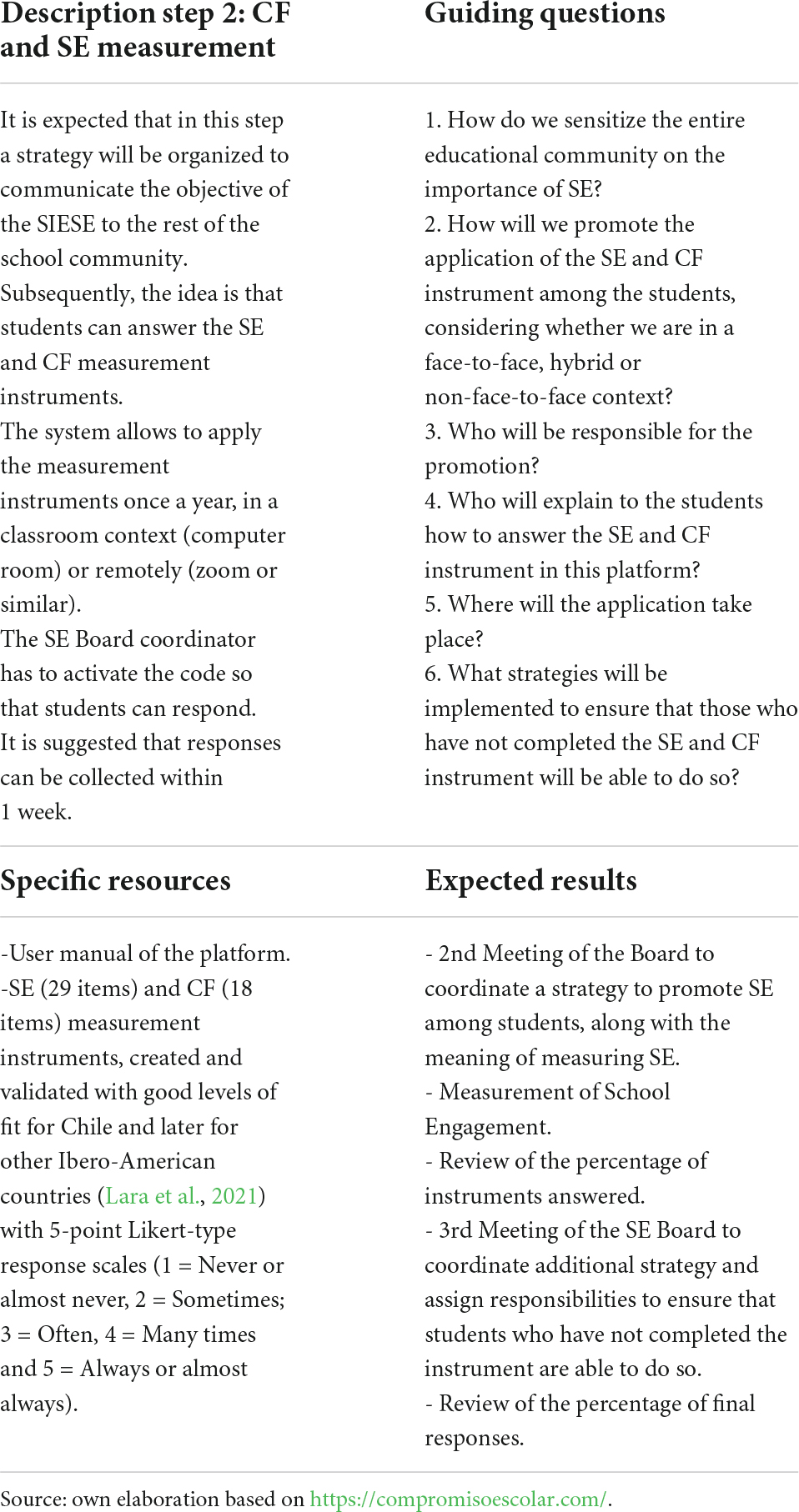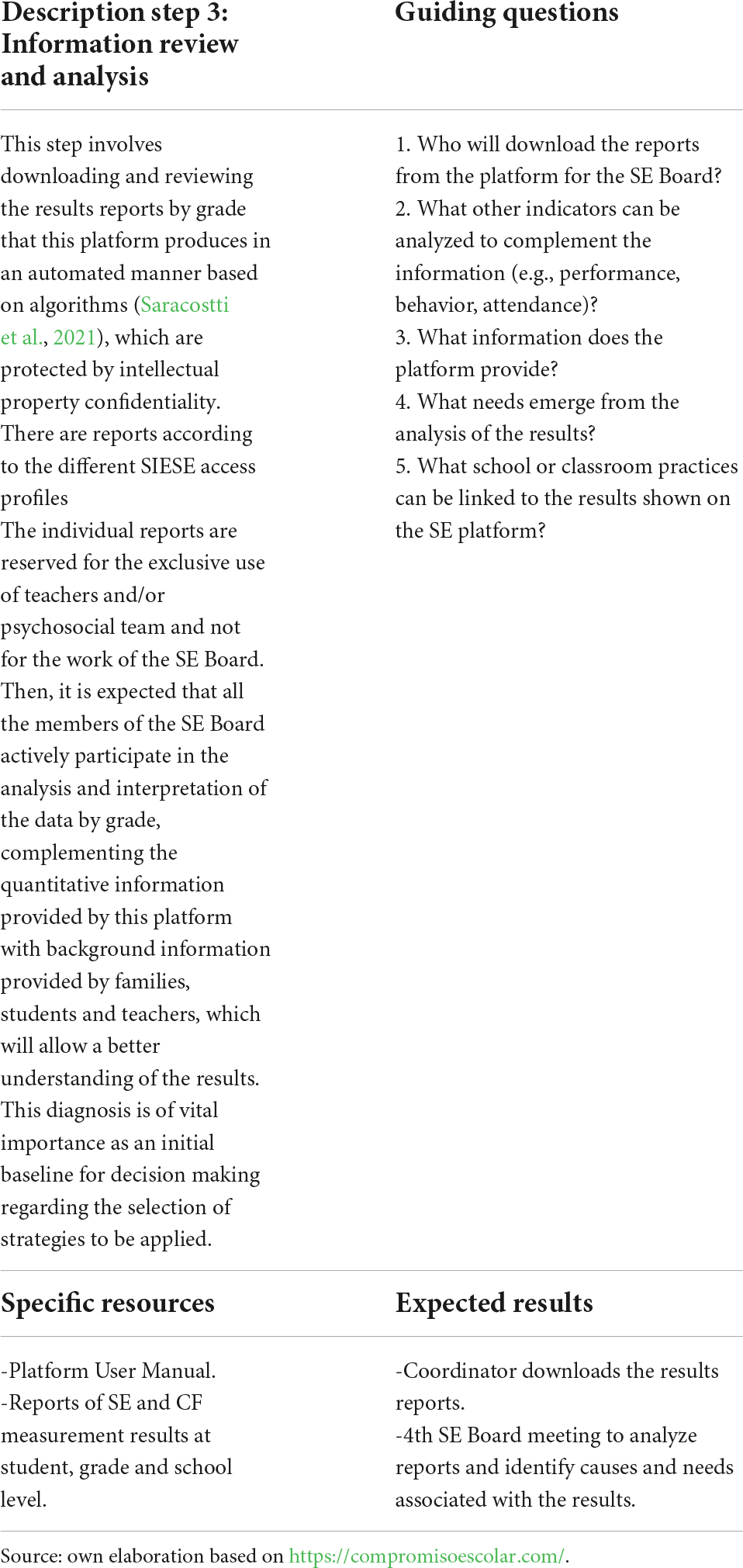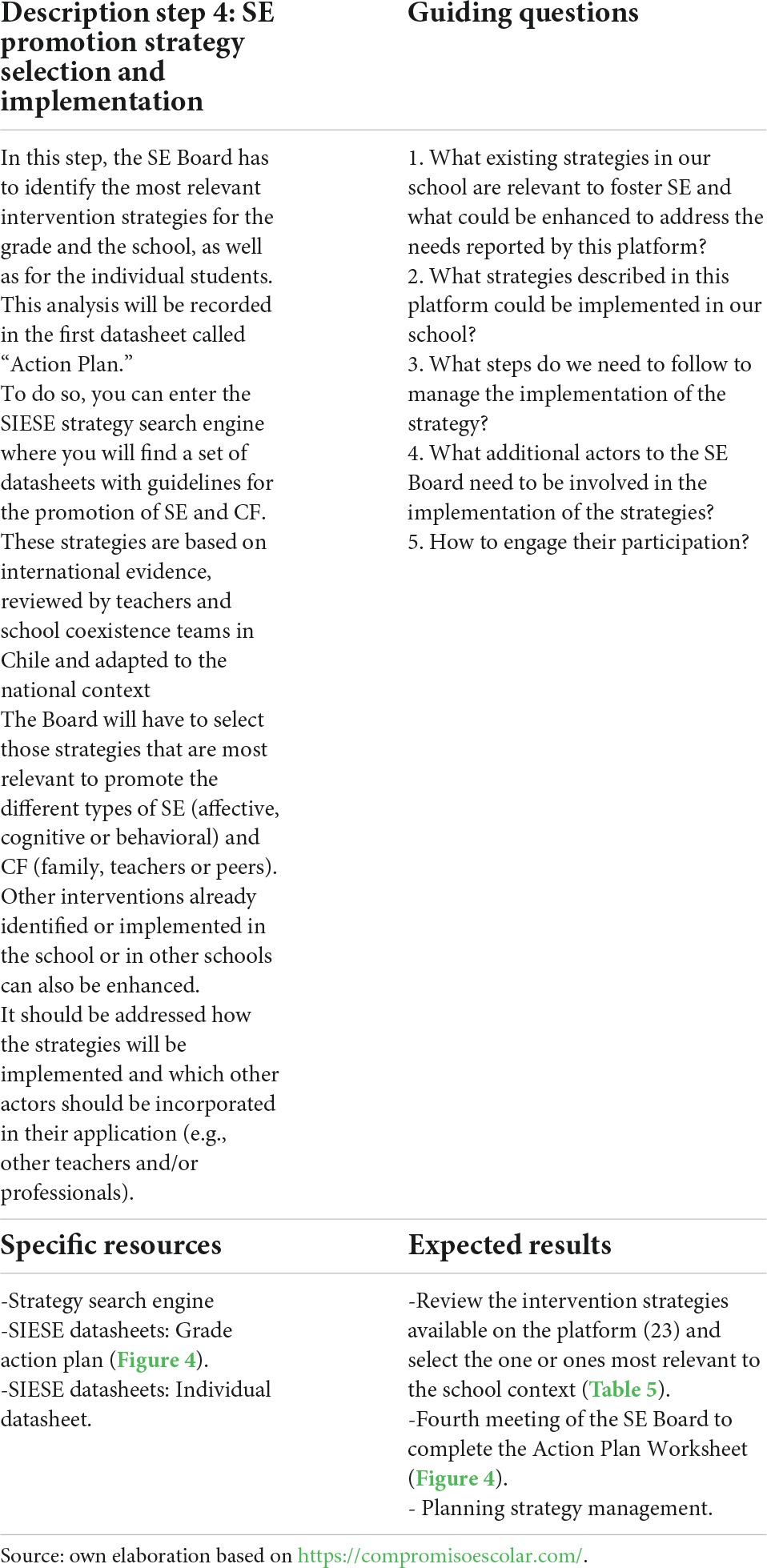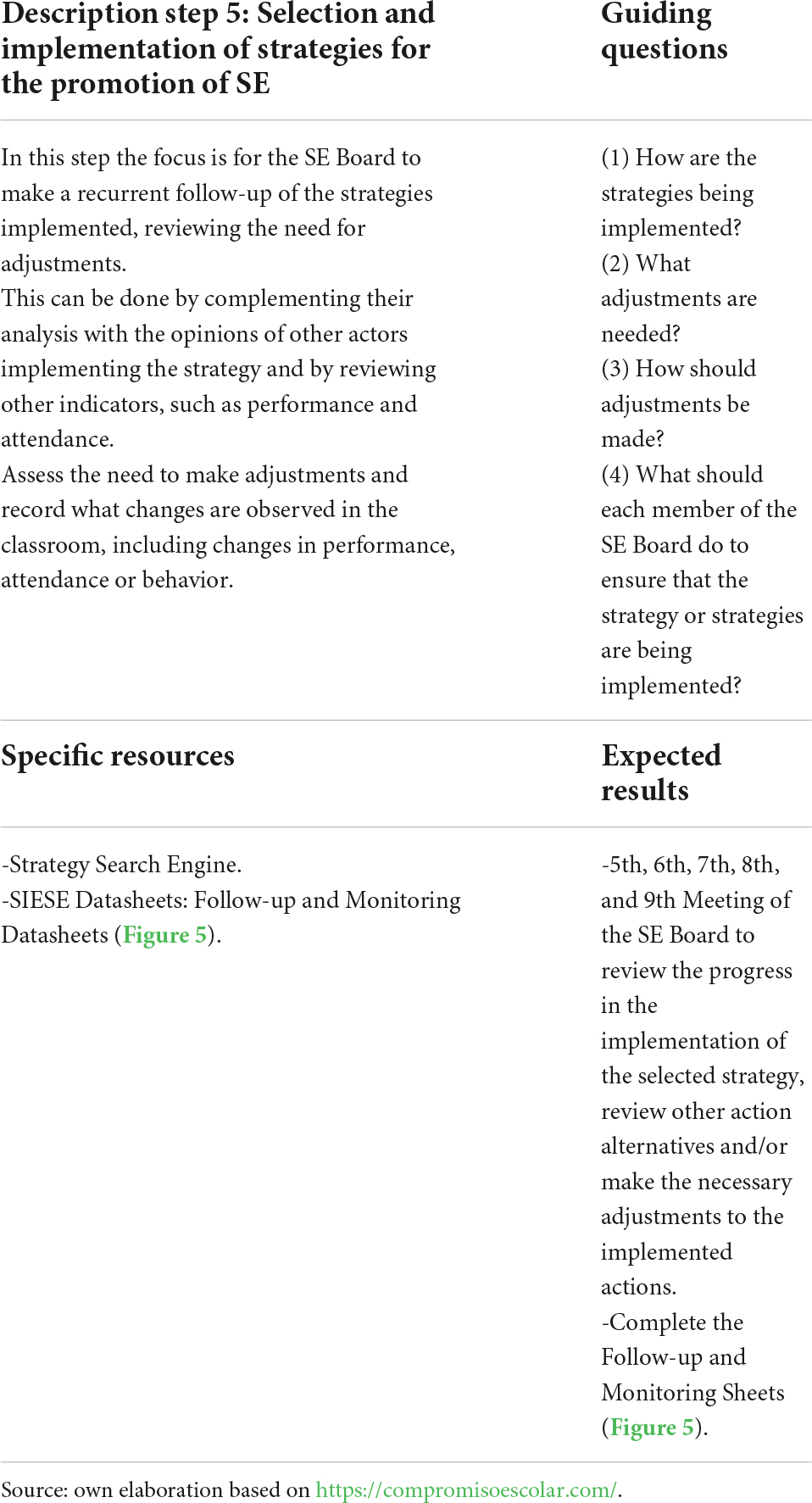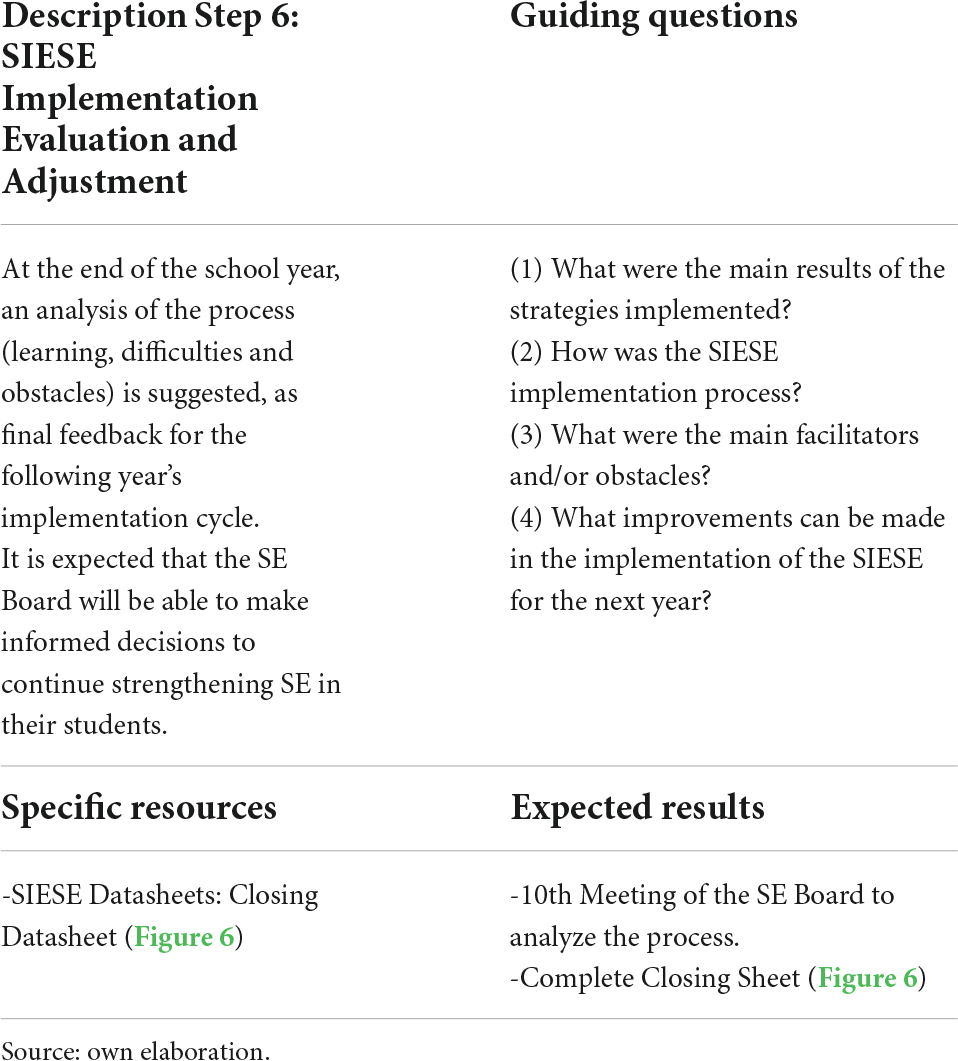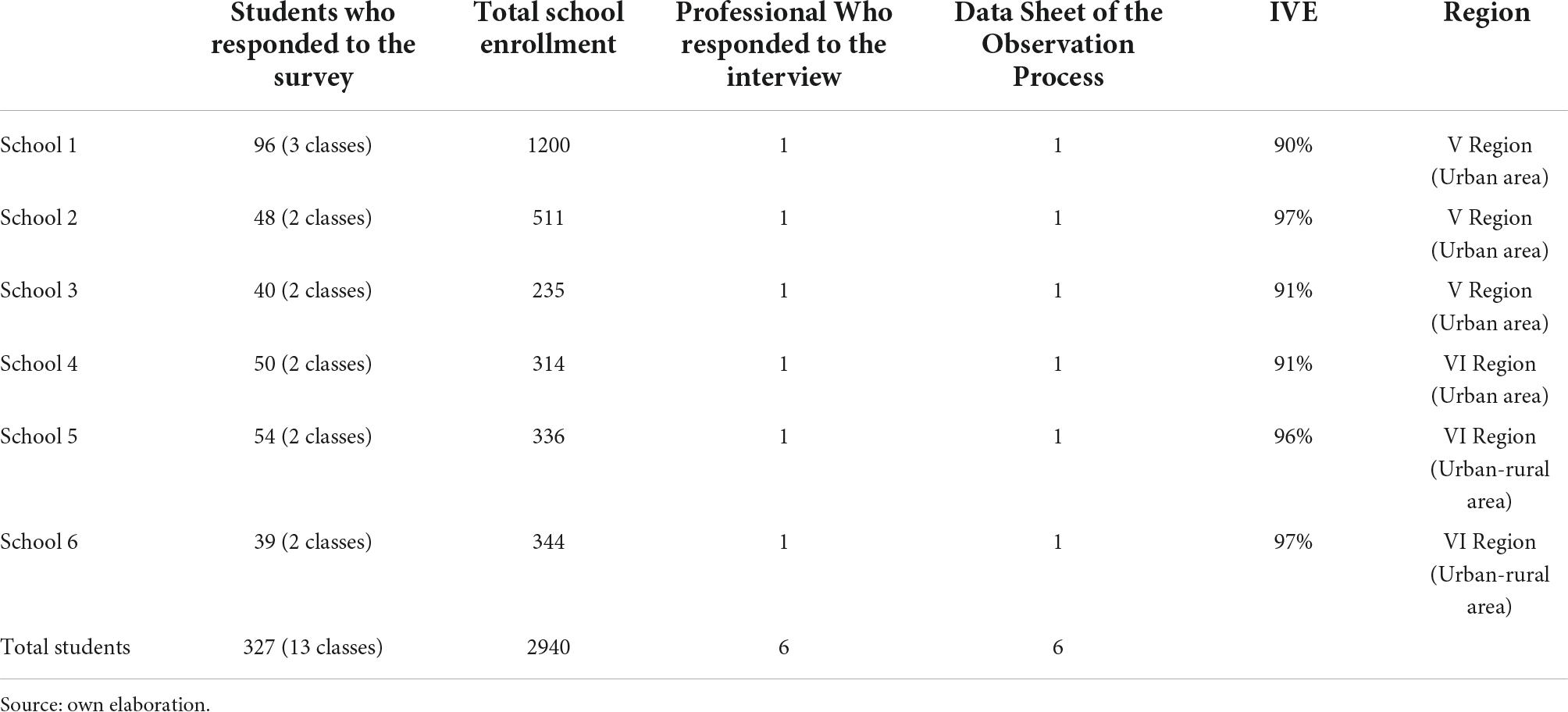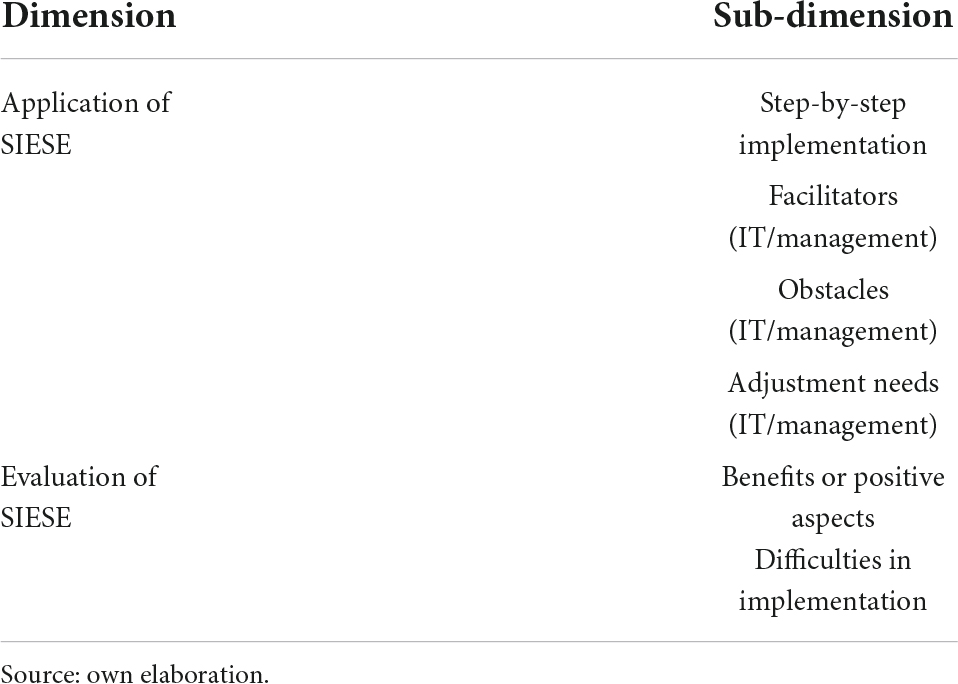- 1Cátedra UNESCO Bienestar de la Niñez y Juventud, Educación y Sociedad, Escuela de Trabajo Social, Universidad de Valparaíso, Valparaíso, Chile
- 2Núcleo Científico Tecnológico en Ciencias Sociales y Humanidades, Universidad de la Frontera, Temuco, Chile
- 3Departamento de Trabajo Social, Pontificia Universidad Católica de Chile, Santiago, Chile
- 4Departamento de Psicología, Universidad Autónoma de Chile, Santiago, Chile
- 5Departamento de Psicología Evolutiva y de la Educación, Universidad de Sevilla, Seville, Spain
This paper presents the implementation and usability of a technology-based web system and the available evidence on educational engagement’s predictive capacity to influence students’ educational trajectories in Chilean schools. The web-based system was developed through collaborative work between universities, the information technology team, school communities, and stakeholders (government institutions). It is an online system composed of six steps whose axis is centered on a decision-making space between teachers-students-parents (School Engagement Board) tasked with applying online and scientifically validated school engagement and contextual factors measurement instruments, checking specific report results for each actor involved in the system (teacher, School Engagement Board coordinator, school) as well as reviewing promotion strategies relevant to the school context and managing the implementation of strategies supported by the management datasheets that the model offers to schools. The objective of this paper is to present the usability of the system through a case study of the implementation in Chilean public schools. In order to discuss about what elements should be incorporated to adjust and improve the usability of the system and to guarantee its effective implementation, the paper describes those aspects that have favored and/or hindered the use of this educational technological platform in the Chilean case. The results show that there have been more difficulties related to management aspects than IT aspects, which indicates that these conditions are critical for implementation, even when system for evaluation, monitoring and strategies for the promotion of student engagement and contextual factors (SIESE) is designed for stand-alone use. Although there are aspects to be improved, such as extending its use to other browsers, improving the intervention guidelines and other systems functionalities, this web-based system has been considered by the educational communities as a simple, useful, and intuitive platform. The paper concludes on the importance of having this type of platform in Chile and other Latin American countries, for its contribution to school management -being helpful for day-to-day educational practice- due to the different technical facilitators.
Introduction
Monitoring systems for the promotion of successful educational trajectories
Quality education is a fundamental right and is part of the Sustainable Development Goals (SDGs). To achieve this goal, it is vital to promote school retention and prevent dropout. Monitoring systems are one of the recommended measures (Fredricks et al., 2019; Hofkens and Rozek, 2019; de Toro et al., 2021). They are referred to as educational trajectory protection systems or early warning and intervention systems. Regardless of their denomination, prevention and promotion only occur if detection is accompanied by a set of measures. UNESCO (2021) highlights how these systems can become effective tools for reducing dropout, and the importance of linking them with other educational management systems.
Monitoring systems are an essential element to evaluate program and processes, to identify strengths or weaknesses in schools, to contribute to decision-making and carry out educational management processes at different levels, for example at the school, local or government level (Komar et al., 2019). The Chilean Ministry of Education in its Framework for Good School Management and Leadership establishes a specific dimension for the monitoring process, indicating that management teams should monitor the comprehensive implementation of the curriculum and learning achievements in all areas of student training for the improvement of teaching and pedagogical management processes (Leiva-Guerrero et al., 2022). Likewise, Local Educational Services, also by law, must have follow-up, information and monitoring systems that address the evaluation of the processes and results of educational institutions, as part of the continuous improvement of the quality of education.
UNESCO (2021) notes that there are two monitoring systems. The first is a model based on expert knowledge or indicators that identify the most at-risk students. A second model is based on data analysis using machine learning techniques that process large amounts of data to identify trends in the aggregate behavior of indicators by schools or geographic areas. This second model is used when student-level data is not available. While in the models based on expert knowledge there are successful experiences using a few indicators, the other models require a large amount of information, including quality historical data, to produce good results. Moreover, as the latter models use a large amount of data, the information obtained may not be easily understandable. For this reason, the first models are more recommendable.
Indicators with scientific evidence
A fundamental component of monitoring systems is to have scientifically validated indicators that provide schools with clues about what decisions to make to improve the educational trajectories of students. School engagement (SE) is one of the key indicators since abandonment is not usually a sudden act, but rather the final stage of a cumulative process of a loss of commitment to studies (Miranda-Zapata et al., 2018, 2021; Fredricks et al., 2019).
School engagement is considered a primary concept to promote school retention and protect educational trajectories. SE can be defined as the active participation of the students in the educational process, while they are motivated and consider their learning as meaningful. SE is a multidimensional construct with an affective, a behavioral and a cognitive dimension. Affective dimension refers to the level of emotional response of the child toward the educational institution and their learning process, characterized by a feeling of involvement with the school and a consideration of it as a place worth being part of. Behavioral dimension includes student interactions and responses within the classroom, school, and extracurricular settings. Finally, cognitive dimension is the conscious investment of energy to build complex learning that goes beyond the minimum requirements (Shernoff, 2013; Fredricks et al., 2016, 2019; Christenson et al., 2018; Lara et al., 2018; Miranda-Zapata et al., 2018; Saracostti et al., 2019, 2021).
This concept has become even more relevant in times of pandemic and post-pandemic, as remote classes were installed as an alternative modality in the face of the uncertainty of the behavior of COVID-19, with attendance losing strength as an indicator of educational processes (Zhao and Watterston, 2021).
On the one hand, SE is a variable highly influenced by Contextual Factors (CF), mainly by (i) family support; (ii) peer support and (iii) teacher support (). Family factor refers to the fact that students perceive family support in the learning process, in case of problems, with homework, in motivational terms, together with conversations about what happens at school. Pers support has been defined as the perception that students have about interpersonal relationships between classmates, that is, the concern, trust and support that is given between peers. Finally, teacher support refers to the fact that students perceive receiving support and motivation from teachers to learn or in case of any inconvenience (Saracostti et al., 2019; Navarro et al., 2021).
On the other hand, the literature, together with international and national organizations, agree that having systems capable of evaluating, monitoring and promoting the school engagement contribute to prevent school dropout and promote positive trajectories in a much timelier manner than those initiatives that focus exclusively on the classic risk factors such as absenteeism or falling behind in school. The relevance of focusing on school engagement lies in the fact that it is a highly moldable variable and on which schools can intervene, unlike more structural factors such as poverty. Schools and local entities can be benefited from an integrated and articulated system for promoting SE and FC, since it could identify common needs among students and courses that require additional support, while governments Local authorities can focus resources on those schools or areas that need to reinforce their SE, together with evaluating the effectiveness of the available interventions. It is also suggested that these systems be based on robust technical components that do not increase the teaching load (Bruce et al., 2011; de Toro et al., 2021).
Robust technical components
Collecting data on indicators associated with the risk of dropping out is not enough to prevent school dropout. It is necessary a methodology for this purpose (UNESCO, 2021), to have robust technical components and to be connected to a network of interventions (de Toro et al., 2021). Regarding the use of data for the improvement of educational processes, Parra and Matus (2018) recommend having digital registration systems that systematize information and deliver indicators over time, so that strengths and alerts can be quickly and timely identified; and on the other hand, to follow up in the different educational periods. The web-based school system software automates school operations and helps to reduce management burden.
Based on an incremental scientific-technological development, the Web-Based System to Measure, Monitor, and Promote School Engagement Strategies (SIESE), easily and quickly accessible at https://compromisoescolar.com/ allows measuring, monitoring and intervening on the basis of automated reporting in favor of School Engagement (SE) and the Contextual Factors (CF) which influence it of students in educational transition from 5th grade (or 5th grade of primary school, 10−11 years old) to 12th grade (secondary school or 2nd year of high school, 17−18 years old) (de Toro et al., 2021).
System for evaluation, monitoring and strategies for the promotion of student engagement and contextual factors has been perfected and adjusted to the reality of diverse educational community contexts to integrate on-site the requirements for its proper use. For this reason, throughout the incremental scientific-technological development, based on different R + D + i projects, which resulted in the SIESE, platform operation was evaluated and adjusted according to the suggestions and observations for improvement of the participating educational communities of the country (de Toro et al., 2021). In addition, SIESE contains scientific validations of (i) measurement tools of SE and FC (Lara et al., 2018, 2021, Navarro et al., 2021; Sotomayor et al., 2021), (ii) predictive model of the Effect of School Engagement on Attendance to Classes and School Performance that is at SIESE base of operation (Miranda-Zapata et al., 2018), and (iii) strategies proposed (Leyton et al., 2021).
System for evaluation, monitoring and strategies for the promotion of student engagement and contextual factors was developed using SCRUM methodology (de Toro et al., 2021), which is a lightweight software development methodology that relies on incremental development and focuses on delivering several iterations of a product. It was developed through collaborative work between the university team (researchers), information technology team, school communities, and stakeholders (government institutions).
Technical details of the software and hardware that supports the different components of the technological platform, which should be considered at the time of installation and transfer, are detailed as follows:
• User Layer: The client application for accessing the measurement instruments, intervention strategy record cards, and downloading reports are executed through a Web browser installed on the accessing computer, preferably Chrome or Firefox. Mobile accessibility stands out in this layer so that participants can access the surveys and reports using mobile devices such as tablets or smartphones to facilitate the application and distributed follow-up.
• Applications Layer: Consisting of the server where the modules for authentication, measurement instruments, reports and longitudinal monitoring, and strategies and record datasheets for the actions implemented in the respective classes and schools are installed. The measurement instruments in an online format were developed based on LimeSurvey technology that uses the Yii (PHP) development framework as a base. In the case of the results report visualization module, these were developed using HTML, JavaScript, CSS, and PHP development environments.
• Data: Consisting of the database in which the information of each participant in the measurement process is stored, as well as the profiles associated with the management of the platform and the educational resources available (audios, videos, documents, etc.). The database implemented the MySQL engine, running on a centralized, high-performance server (24/7) and available in the cloud (Internet) under Linux operating system and Apache Web server.
Background: Use of system for evaluation, monitoring and strategies for the promotion of student engagement and contextual factors through its 6 steps
System for evaluation, monitoring and strategies for the promotion of student engagement and contextual factors, which is based on the Early Warning System developed by the National High School Center of the American Institute for Research (AIR, 2020), proposes the sequential execution of 6 steps: composed of 6 steps: (i) Step 1: Formation of the SE Board; (ii) Step 2: Measurement of SE; Step 3: Review and analysis of the information; Step 4: Selection and implementation of strategies; Step 5: Monitoring of students and strategies; Step 6: Evaluation and adjustment of the implementation of the System (de Toro et al., 2021).
Each step is briefly described below, as well as some guidelines for their execution (Tables 1–7):
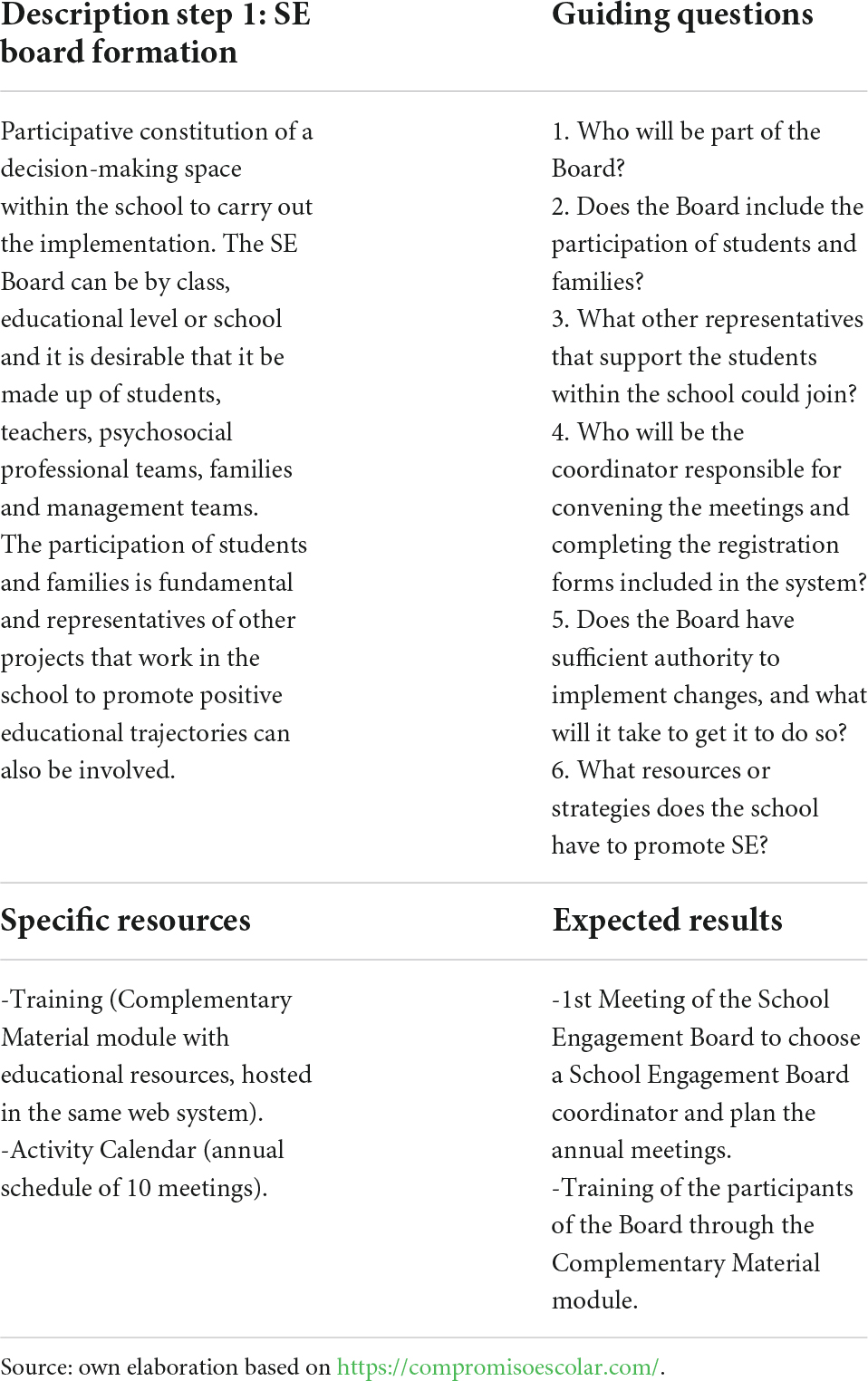
Table 1. Implementation of step 1: System for evaluation, monitoring and strategies for the promotion of student engagement and contextual factors (SE) board formation.
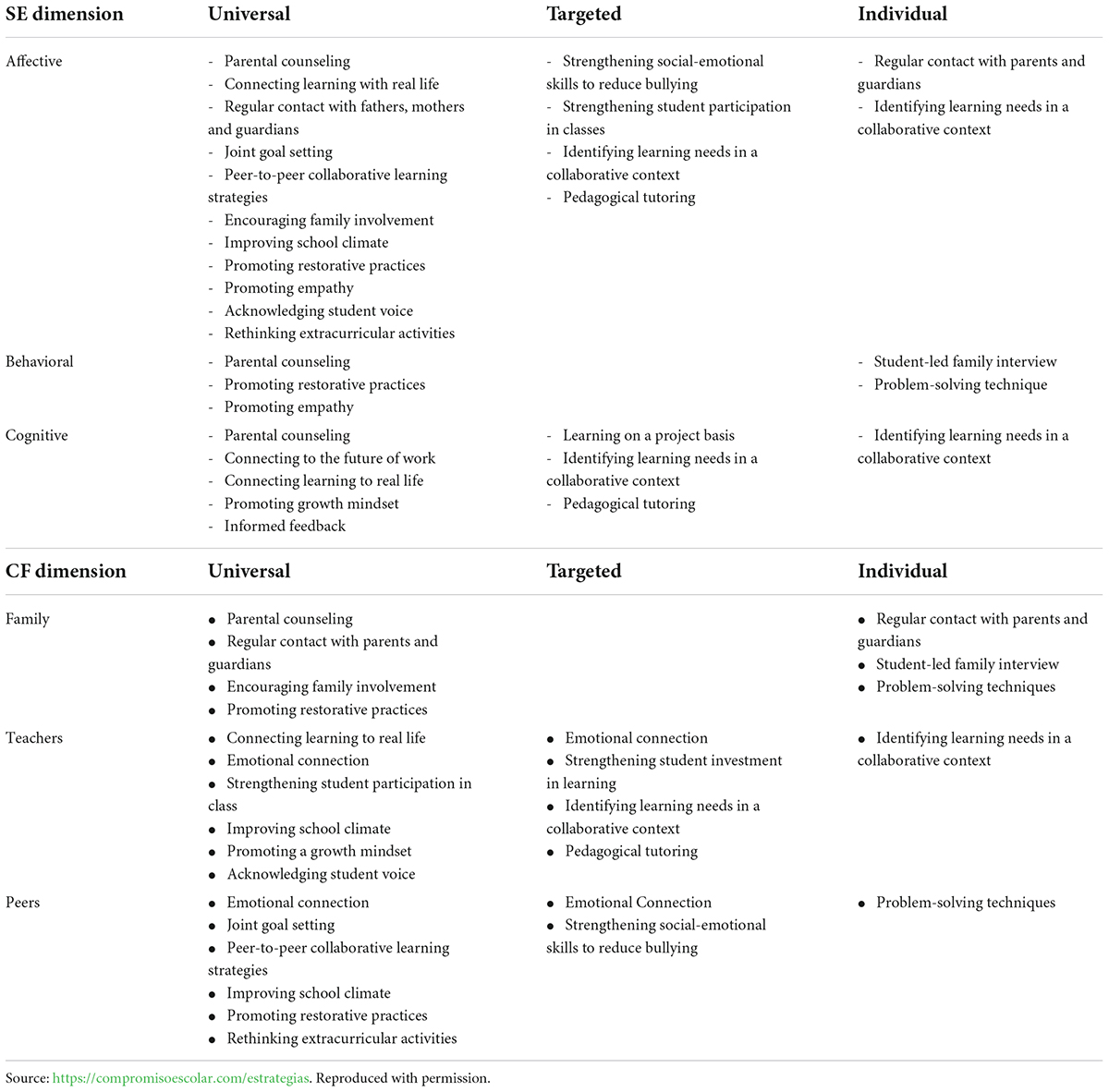
Table 5. Summary of the strategies proposed in the SIESE, according to SE dimension and Contextual Factors.
Those who are participants in the SE Board, as well as any other member of the educational community who so desires, can be trained through the same platform in the Complementary Material module by means of seven short videos, publications on conceptual and methodological aspects, technical documents, seminar and/or webinar records, frequently asked questions, among other resources. The SIESE also has a User’s Manual, a guiding document to optimize its use.
Once the SE Board is constituted, the schools can lead the second step, which is related to the process of applying the measurement instruments (Table 2).
Once the students have answered the SE and CF questionnaires, the SE Board can analyze the data recorded in the platform and establish a diagnosis (Table 3).
System for evaluation, monitoring and strategies for the promotion of student engagement and contextual factors provides annual (annual measurement) and follow-up (or longitudinal) reports for cases where more than one measurement has been made, at the school, grade and student level. The following is a description of how the data are presented in each of these reports, considering the graphs to support their interpretation.
Annual reports: At student level
The analysis of results per student can be based on two readings: through the scatter graph (Figure 1) considering four possible profiles (high SE and low CF; high SE and high CF; low SE and low CF; low SE and high CF) and through the SE and CF graphs (Figure 2), which allow identifying signs of strengths and alerts, without showing scores in order to avoid stigmatizing boys, girls and adolescents [BGA] (Saracostti et al., 2021).
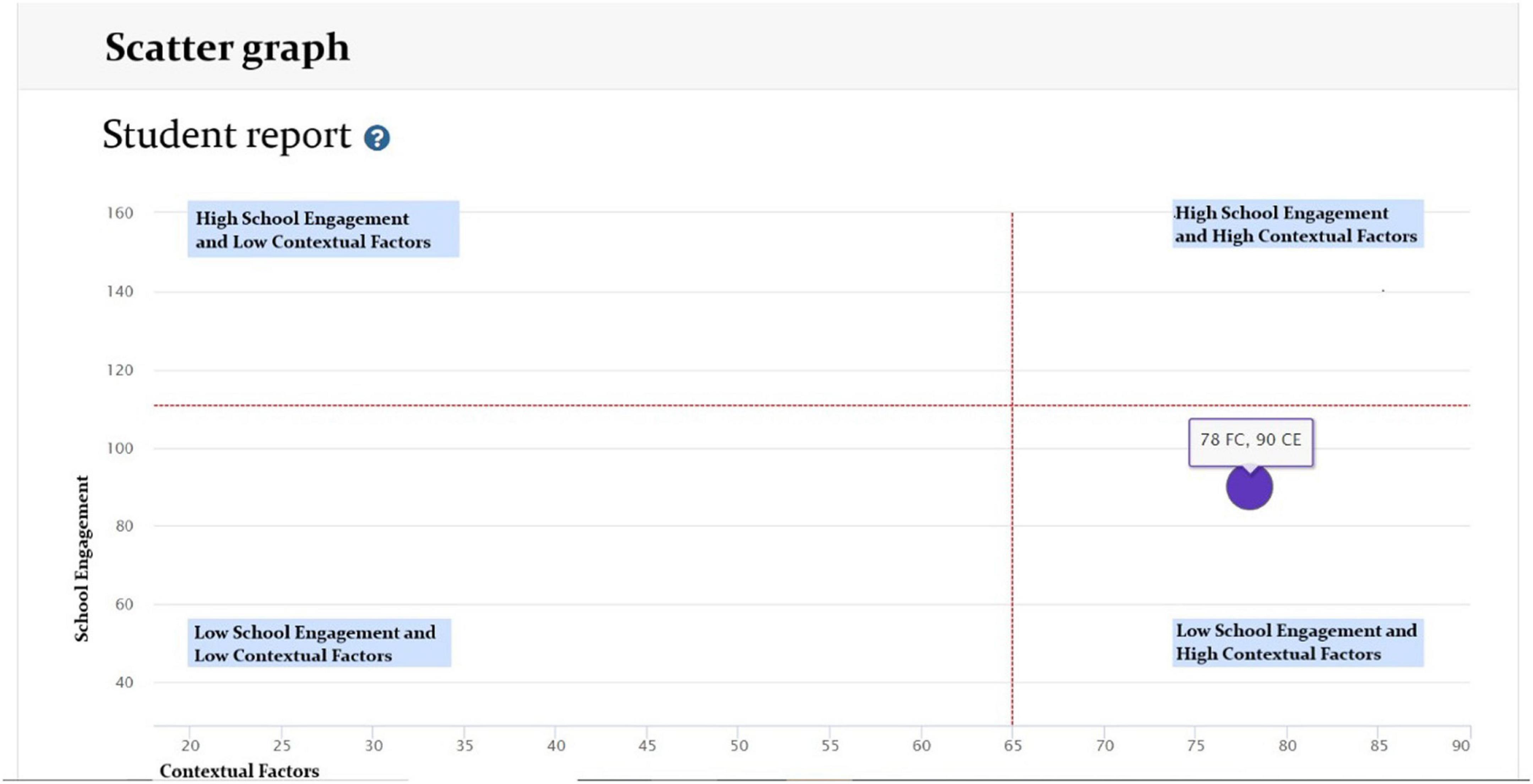
Figure 1. Example of results by system for evaluation, monitoring and strategies for the promotion of student engagement and contextual factors (SE) and contextual factors (CF) dimensions of the Student Web Report (scatter graph). Source: https://compromisoescolar.com/. Reproduced with permission.
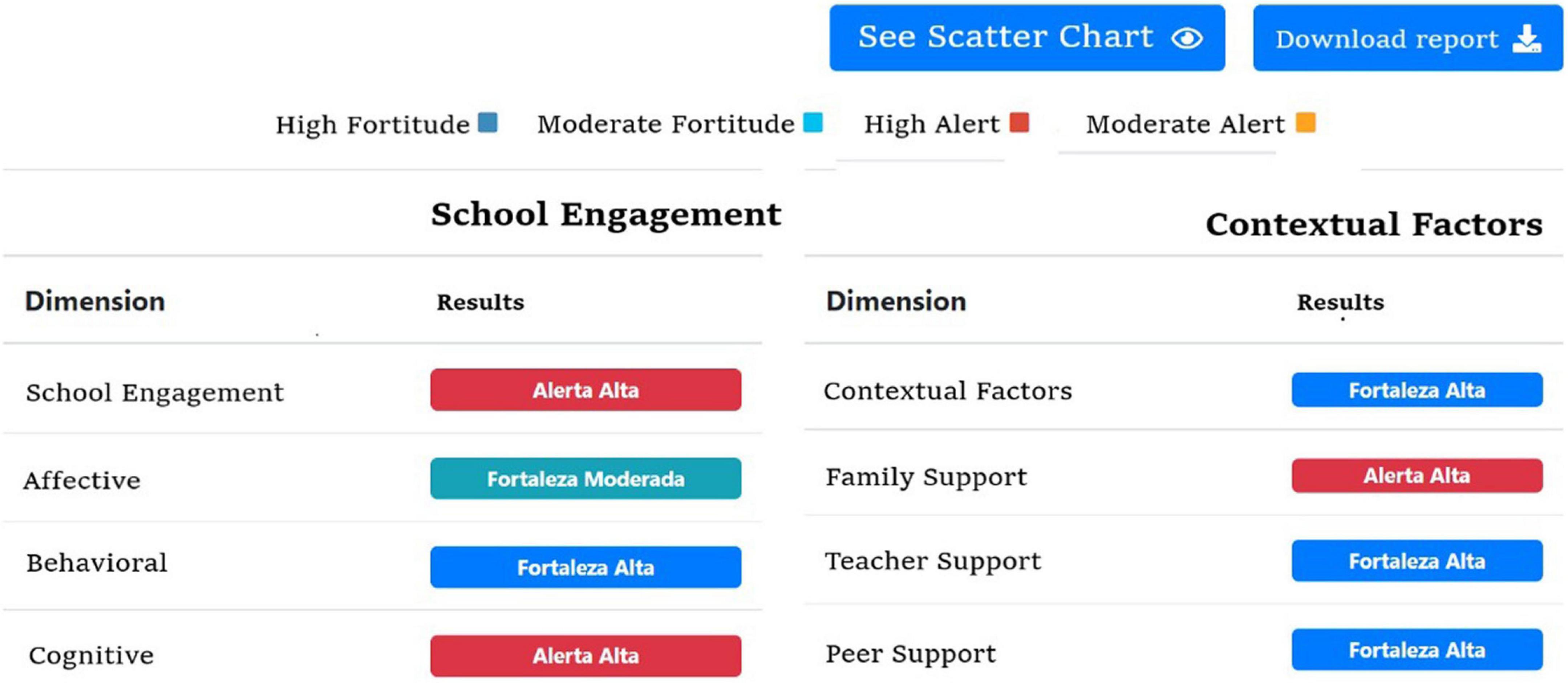
Figure 2. Sample of SE and CF Alerts and Strengths results from the Student Web Report. Source: https://compromisoescolar.com/. Reproduced with permission.
Once teachers and/or education professionals and the SE Board Coordinator review both types of graphs, it is suggested to take note of the most relevant aspects for later discussion at the SE Board. The interpretation of student reports is of vital importance for targeted and/or individual interventions.
Annual reports: At grade level
In addition to the scatter graphs that place each grade on axes of intersection of high and low levels of SE and CF, the reports by grade also contemplate pie charts that represent the percentage of students in each dimension of SE and CF at four levels of SE development (emerging, developing, satisfactory, highly developed) and four levels of CF (low, medium, high and very high) (Saracostti et al., 2021).
The report by grade also allows visualizing the concentration of students per item of each SE dimension (e.g., “When I am studying, I write down new words, doubts or important ideas,” “I feel that I am important to the school,” or “I behave in class”) and CF (e.g., “I talk to my family about what I do at school,” “My classmates support me and care about me,” or “Teachers care about me not only as a student but also as a person”), according to each response level (Never or Almost Never, Sometimes, Often, Many Times, Always or Almost Always).
Annual reports: At school level
Each educational institution can have scatter graphs of four profiles similar to Figure 1, which allow locating the levels of SE and CF, considering all the grades that participated in the measurement (Saracostti et al., 2021).
Monitoring or longitudinal reports: For multiple schools (for educational administrators), by school, grade level and student
Longitudinal reports make it possible to analyze over time, establish trends and follow up on the grouped or individual behavior of students in order to identify changes in advance and intervene in a timely manner (Figure 3). Considering also that the SE and CF measurement instruments were created and validated for students from 5th to 12th grade, it would be possible to monitor and follow up during an important period of the students’ school career (Saracostti et al., 2021).

Figure 3. Examples of follow -up reports: “Administrator” Profile [A]. “Educational Institution” [B] Profile follow-up report. Source: https://compromisoescolar.com/. Reproduced with permission.
At the student and grade level, it is possible to access results reports similar to those shown in Figure 3.
Once the data has been analyzed through the different accesses to results that SIESE allows the SE Board must socialize this information to develop a collaborative decision-making process in order to promote SE and CFs of its students.
To support the educational communities in this process, the platform offers guides to the actors involved in the selection and implementation of strategies that are relevant to their school context (Table 4).
Once the search for strategies relevant to the results reflected in the reports provided by the SIESE has been carried out, it is possible to access explanatory sheets of the SE and CF promotion strategies, in web and downloadable versions, in order to select the most appropriate ones for the school context and student needs (Leyton et al., 2021). In addition, if you prefer to know all the strategies at once, it is possible to access a downloadable compendium (Table 5).
Each strategy indicates the sub-dimension of the SE and/or the CF it seeks to enhance. Each strategy sheet also indicates whether or not it is applicable in a non-face-to-face context, and whether its implementation is individualized (with one student), targeted (with a group of students) or universal (with the entire class or school) (Table 6).
Once the strategies have been selected, the SE Board can fill in the “Action Plan” sheet (Figure 4) with the interventions identified as relevant to be implemented in their school context.
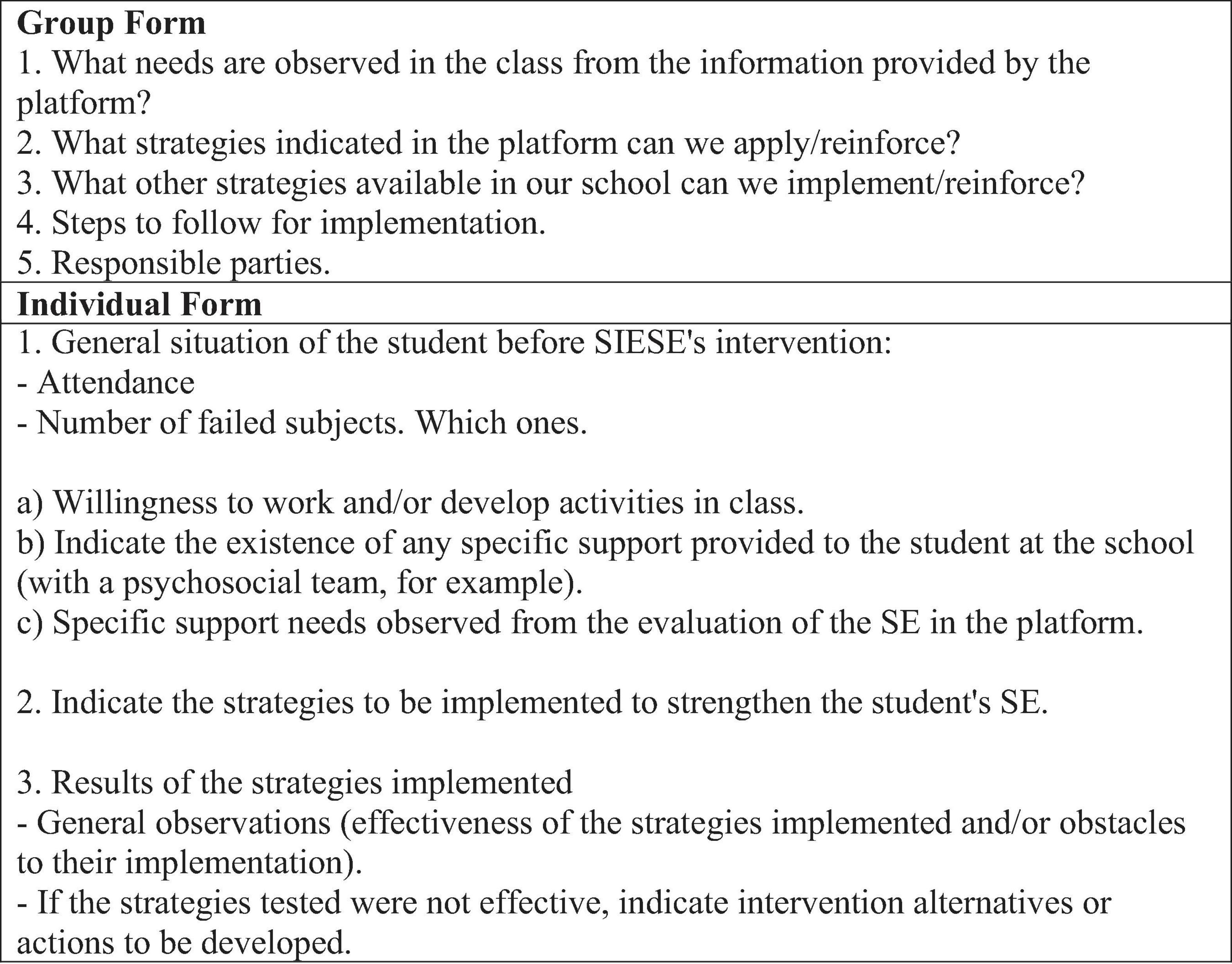
Figure 4. Items to be completed in the action plan worksheet. Source: own elaboration based on https://compromisoescolar.com/.
Although SIESE is based on the comprehensive perspective of education as a universal right, it also allows, in a complementary manner, the registration of targeted interventions in cases that merit it. In relation to this last level, the use of the Individual SIESE Form supports decision making for specific student situations that require a more personalized intervention. In the same way, confidentiality and ethical management of the data entered in the Individual SIESE Form must be ensured (Figure 5).

Figure 5. Items to be completed in follow-up and monitoring datasheets. Source: own elaboration based on https://compromisoescolar.com/.
This Individual SIESE Form records that the intervention actions should be oriented to the promotion of CF. Complementarily, it is possible to evaluate joint actions associated with other management systems present within each school. The last step of the implementation of the SIESE system includes the final evaluation and adjustment, as seen in Table 7 and Figure 6
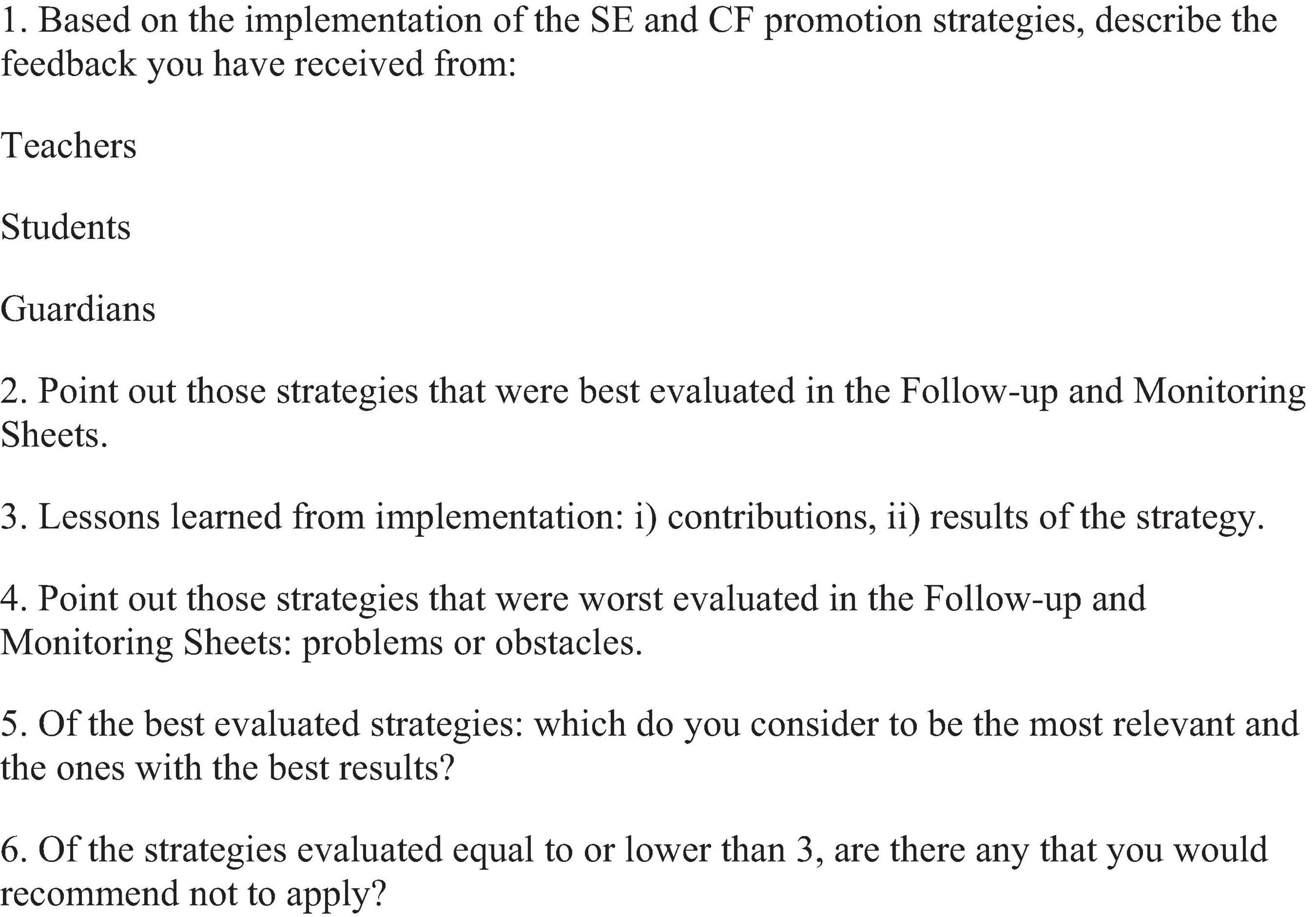
Figure 6. Items to be completed in closing datasheets. Source: own elaboration based on https://compromisoescolar.com/.
Materials and methods
Design
This paper shows the results of a qualitative and descriptive multiple case study. A case study allows to explore different parts of a phenomenon, and the way in which events, actors and structures converge in the same space (Yin, 2018). Each case is understood as a school in which the SIESE was applied throughout the school year. Being a case study, in-depth contact with singular realities was privileged over a large number of individuals as a source of information.
Sample
The study considered six public schools with a high level of school vulnerability (about 90%) in two regions of Chile (V and VI Regions) belonging to the country’s central macrozone. The V Region of Valparaíso is the third most populated region in Chile, mainly urban and 19% of its population is in multidimensional poverty. The VI Region of Libertador Bernardo O‘Higgins represents 5.2% of the national population (sixth most populated in Chile), with a 25.6% rural population. The poverty rate (7.9%) is higher than the national rate (6.3), although multidimensional poverty is lower (18.5%) than the Chilean average (20.7%).
In Chile, public school students come from families with lower incomes and lower socio-cultural capital, which represents the segregation of the Chilean educational system. A high level of school vulnerability is equivalent to <85%. School Vulnerability Index (IVE, in Spanish) calculated annually by the National School Aid and Scholarship Board (JUNAEB, 2005), which ranges from 0% to100%, where the higher the percentage, the higher the vulnerability index. This percentage indicates the proportion of students defined as priority students (JUNAEB, 2005; Brunner, 2006). This index is measured according to poverty conditions and risk of school failure, including variables such as family socioeconomic context, access to the health system, housing quality, and parents’ educational level, among others. For school recruitment, this index is important as it is directly related to exclusion and dropout factors.
This is a convenience sample, (Please review the participant sample in Table 8), as it considers those schools that meet the vulnerability criteria and with which the research team has worked in previous studies.
Procedure
A socialization strategy, in which SIESE was presented to a large number of schools and school administrators was carried out to recruit schools that would be part of the study. Six schools were selected that voluntarily decided to participate in the SIESE application.
The schools implemented SIESE during the 2021 academic year (in the context of the pandemic quarantine) at the 7th (12−13 years) and 8th (13−14 years) grade levels. These educational levels were chosen because in Chile they correspond to the educational transition between primary and secondary education. Likewise, in the pre-pandemic context, the highest level of dropout was mainly at the next level (1st grade or first year of secondary school), so identifying the variables that influence this phenomenon was relevant if it was focused on the levels prior to this educational transition.
As a first step, schools were contacted to sign a commitment to participate. Each child responding to the survey was asked to sign an informed assent, while parents were asked for their consent. The pilot schools supported the formation of a School Engagement Board charged with implementing the six steps of the SIESE. During the first semester all coordination and applications were done virtually, while in the second semester they were done in person. The accompaniment was done through telephone, zoom and/or face-to-face meetings mainly with the coordinators of school engagement boards.
The project was approved by the ethics committee of the Universidad Autónoma de Chile (CEC 10−20).
Techniques used
Data collection was qualitative in nature through the technique of participant observation of a member of the research team who accompanied the implementation of the SIESE during the school year. Participant observation is understood as a technique that involves interaction between the researcher and the informants (Taylor and Bogdan, 1984), during which data were collected in a systematic and non-intrusive manner.
During the observation process, data sheets were used (1 for each school), which were to be completed by the field researchers for each step of the SIESE implementation process and allowed collecting information on aspects that facilitated and/or hindered the proper development of each implementation phase, related to: (i) the use of the platform, (ii) emerging doubts, (iii) autonomy in the implementation of SIESE based on the information provided, (iv) emerging computer problems; as well as suggestions for improvement. This was complemented with the development of semi-structured interviews to 6 school professionals (1 of each school) who participated actively in the implementation of SIESE, through the School Engagement Board.
Data analysis
The information collected from the data sheets of each implementation process, interviews and the experience of the research team was analyzed using the technique of thematic analysis. Following Braun and Clarke (2006), thematic analysis is understood as a method to identify, analyze and report patterns from the data, exploring common patterns, congruities and incongruities among participants. Table 9 describes the dimensions that were taken as reference at the time of the analysis:
Results
The following is a description of the results obtained from the follow-up of the six schools that implemented SIESE along four lines: facilitators, obstacles, opportunities for improvement and suggestions for its implementation. The above, considering both the IT and management aspects of SIESE.
Facilitators for system for evaluation, monitoring and strategies for the promotion of student engagement and contextual factors implementation
Resources to support the implementation of system for evaluation, monitoring and strategies for the promotion of student engagement and contextual factors
To facilitate the implementation of SIESE, a manual was developed to promote capacity building and autonomous management. In addition, participants had access to the training module which, based on suggestions from the educational institutions, was changed from an online course to a module of interactive videos of approximately 3 mins each. According to field researchers “reports the development of audiovisual material was chosen due to the difficulties associated with the availability of sufficient time for reading” (data sheet, school 2).
Internal organization of schools
With respect to the formation of the School Engagement Board and the planning of the sequential process proposed by SIESE, participant observations point out that: “implementation was easier in those schools with a high degree of autonomy and self-initiative, recognizing this cultural aspect as a facilitator at the organizational level” (data sheet, school 6). Considering field notes, “previous existence of School Councils facilitated the creation of the SE Board” (data sheet, school 4), as well as “the motivation of teaching teams to incorporate new strategies in their curricular designs” (data sheet, school 1).
Leadership committed to system for evaluation, monitoring and strategies for the promotion of student engagement and contextual factors
The coordination of teams within a school is a key aspect to consider for the development of SIESE steps. In this context, although it is not an element of SIESE itself nor is it linked to its usability, participant observations indicate that: “the leadership characteristics of management teams, reflected in strategies for convening teaching teams and ability to socialize SIESE, motivating its integration and development, is considered a facilitator to ensure the implementation of the steps” (data sheet, school 3). This was also relevant to facilitate student participation and understanding during the application of the measurement instrument. In addition, according to interviews, faced with emergent situations during the measurement process, in cases where “there was more than one teacher to support the process, it was possible to better meet the different requirements” (interview, school 6) such as verbal communication with students, the projection of the sequence of steps to follow on screen, as well as the attention to doubts and support via chat, the copy of codes and the review of the platform to corroborate the completed surveys.
Mass uploading of students
Schools received the students’ access keys to enter the platform (tokens), which were generally distributed through institutional e-mail. In this regard, it is worth noting the possibility of the platform performing mass uploads of students to cover a larger population of students and achieve nationwide coverage. This is a key aspect referenced in interviews. The users of the teaching and management teams must ensure the correct entry of the access codes to avoid problems during the application of the instruments and explain the process well: “At the beginning it was a bit confusing because it was applied to all the classes together and the children were confused with the codes” (interview, school 1).
Instruments easy to use by the students
Field workers reports evidence the application of the assessment instruments was further facilitated by the students’ familiarity with the technological platforms and because these were developed into a responsive version. Thus, they were able to access the instrument from a computer, tablet or mobile phone. “There were no major difficulties for students to answer the instrument, which was understandable and quick to apply” (data sheet, school 3). The results of the surveys also make sense to them: “The data coincide with reality, as they match with other measurements carried out (for example, in relation to school coexistence problems” (interview, school 6), except for the family support factor, whose interpretation generated certain misunderstandings as it was the factor with the fewest items in the survey.
Simple, useful, and intuitive platform
From participant observations, school teams highlighted the ease of use of SIESE in its navigation, being highly valued the platform, the forms and the information provided in the reports to support the work of teachers in school retention: “Excellent platform, very practical and intuitive” (data sheet, school 6). “The platform is different from all the previous ones; it has functions that allow to record changes and actions. It provides guidance with good strategies. It has a methodology that allows to guide the action and making a good assessment” (interview, school 5). “I liked SIESE, it was very well used by the psychosocial team that was able to articulate the different interventions that are carried out by that team” (interview, school 2).
They emphasize that reports are useful as they contribute to school management: “The results show aspects not previously observed in the school; for example, that students feel supported at school. The survey has made it possible to objectify data on certain perceptions of the school’s teaching and management teams” (interview, school 4). The fact that it is intuitive facilitates the autonomous use of SIESE, although its autonomous use without an advisory research team is undoubtedly a challenge and a line of research for future projects.
Obstacles in the use of system for evaluation, monitoring and strategies for the promotion of student engagement and contextual factors
Obstacles were more related to the management of SIESE, since technological difficulties visualized throughout the process were improved.
Formation of school engagement boards
Their consolidation was difficult, as schools and teachers had a high demand for additional tasks due to the pandemic. There were also difficulties in meeting regularly according to the proposed schedule. This is something registered among field reports. In this regard, school professionals alluded to “difficulties in meeting as the implementation of SIESE did not anticipate the professional hours assigned within the school” (data sheet, school 5). In addition, there were complexities due to the high level of teacher absenteeism, associated with medical leaves, which implied for the schools a series of adaptations such as merging classes due to lack of teachers and being in permanent solution of contingency problems. Finally, in some cases, there were difficulties in holding meetings with all the members of the Boards, having to hold separate meetings in some cases with teachers, parents, and students to analyze the results and select strategies, since it was difficult to coordinate with everyone at the same time.
Participation of students and parents
Although SIESE model stresses the importance of children and parents being part of the decision-making team, their participation was more of a consultative nature: “the students participated, but we had to ask them for their opinion” (interview, School 5). “There was a good intention of the Boards actors to guarantee student participation and to listen to their opinions, but most of the interaction was between adults” (data sheet, school 4). This shows certain difficulties in developing spaces for intergenerational interaction and decision-making in a virtual context, and the importance of integrating strategies that allow the active participation of students and parents, since their participation was highly valued when they were effectively included: “children were able to participate, see their interests and collaborate; this motivated them. It also made it possible to recognize changes in them, after some strategies” (interview, school 3).
Dedicated time
The high work overload of teachers eroded the continuity of certain periodic activities proposed by the SIESE, such as reviewing materials, recording and analyzing information in a more systematic way for making decisions regarding the implementation and follow-up of strategies (fields reports). In this sense, the school’s experience points out “the need to resort to the preparation of materials and activities for the implementation of strategies, which requires management teams” (data sheet, school 6). This complexity was less preponderant in those cases where there was prior knowledge and integration of some strategies in schools.
Connectivity
According to participant observations, “connectivity is a variable to consider when planning and developing the SIESE implementation in schools” (data sheet, school 3), taking into account this obstacle of an external nature when children answered the instrument from their homes due to the pandemic, where they did not have a good internet connection. This point may also be an obstacle for rural schools.
Aspects to improve
Extending its use to other browsers
The platform can only be used from the Chrome browser, which was an inconvenience for some users since this requirement was not explicit in the application instructions. On the other hand, field reports observed that, of the total sample, “a very small number of students were unable to answer the survey because they could not pass the CAPTCHA validation” (data sheet, school 1) associated with entering the password.
Improving the intervention guidelines
Datasheets and interviews stated that the strategies proposed by SIESE are useful since they are relevant to the school reality: “Greater interaction and participation among students is observed, developing analysis sessions with the classroom teacher and the psychologist with topics related to routines and study habits” (interview, school 6).
“Parents express the importance of participating in activities that are for their academic benefit and integral development, and that are also necessary for everyone, especially at this age where adolescents sometimes become discouraged, losing interest in studies” (interview, school 4).
However, there is a perceived need for more guidelines for the results analysis phase and for the selection and implementation of strategies. From participant observations, it is suggested that “there should be a guide or a model of the strategies in SIESE to facilitate their implementation without wasting time in creating activities” (data sheet, school 2). Suggestions for immediate intervention could also be incorporated into the reports.
Interpretation of the reports
In order to bring the results closer to students and parents, the interviewers suggested expanding the type of reports available to include versions that can be easily analyzed by students and parents in classrooms or at parent-teacher meetings. It is also suggested to specify in greater detail “how to interpret the statistics presented for teaching teams that were not familiar with the graphs in the reports” (data sheet, school 3), and to specify how the report can guide decision-making in schools.
Biannual application
The platform only allows an annual application per course, but as a suggestion, the possibility of applying at the beginning and at the end of the school year to see how school engagement changes from the implementation of SIESE is raised: “We could start with the evaluation in March (beginning of the academic period in Chile), to measure how the year is going” (interview, school 2).
System functionalities
Other suggestions made by the pilot (by interviews and field reports) are: to add a school search engine to facilitate the search by school administrators with a large number of schools under their responsibility (data sheet, school 2); that a teacher can be associated to two schools given that there are those who work in different educational institutions (data sheet, school 3); to allow longitudinal monitoring of the student regardless of transferring to another school. It is also suggested that the system allow “to upload supporting evidence documents” (interview, school 4).
Suggestions for implementation
Teams with hours assigned to system for evaluation, monitoring and strategies for the promotion of student engagement and contextual factors implementation
It is a fundamental requirement that the School Engagement Board coordinators have hours assigned to SIESE implementation within the schools, which is facilitated if SIESE is part of the school’s management policy: “It is advisable to assign professional hours to the project” (interview, school 1). To ensure the execution of the activities proposed by SIESE for its optimal implementation, participants’ observations suggest scheduling the School Engagement Board meetings for the entire year, organizing in advance the subsequent events after the first meeting is held (data sheets, school 1 and 5).
Transfer to different actors
In addition to the school user, there must be a general administrator, which can be a local entity that groups together different schools. In this case, a model of transfer of the platform to the Ministry of Education was chosen, but it is possible to think of a transfer model composed of public or private non-profit actors to facilitate its mass use and support to schools. On the other hand, given the importance of updating the platforms as technology advances or in the face of changes in public policies, a transfer model was developed that allows the Ministry to make the necessary modifications so that it can be updated as technology and the use of the software advances. To facilitate the transfer, a technical guidelines document was also developed that includes examples of how to use SIESE according to the different access profiles (users) of SIESE. This document also specifies the pedagogical roles of all the actors of the educational community involved, as well as guidelines and/or suggestions for the interpretation and use of the data, in order to favor capacity building and autonomy for the implementation of SIESE in schools.
Continuous training
Although the platform allows self-training, users valued instances of support and/or face-to-face training to optimize its use. This is a key aspect collected in participant observations (data sheets, school 3, 4, and 6).
Supervised application of the instruments
Regarding the application of the instruments, according to interviews and field reports, some students needed more support and clarification regarding the correct entry of the codes (without spaces, with or without periods between numbers and initial letter) (data sheets, school 2 and 5). Therefore, it is recommended that the application of the instruments be done with an adult in charge to resolve doubts and during class hours for mass application. In this line, although the SIESE is designed to be used both in face-to-face and distance classrooms, participant observations note that “in non-face-to-face instances, the application of the instruments may take more time than initially estimated and/or agreed upon” (data sheet, school 4). Based on this, the importance of involving parents and student representatives to motivate their children and classmates, respectively, is emphasized.
Follow-up of the action plan
A risk observed in the experience of Step 5 has been the non-implementation of the strategies planned to be applied in the “Action Plan.” To this end, we insist on the recommendation to ensure the implementation of the follow-up meetings suggested in the SIESE to review the planning and adjust, if necessary, according to the real needs and possibilities of the schools, making effective use of the monitoring sheets hosted on the platform. It was also suggested that the Action Plan Worksheet should allow “Adding evidence, uploading supporting documents, attendance data, audiovisual files” (interview, school 4).
Continuity over time
Given that the changes in SE and CF after the implementation of the strategies cannot necessarily be visualized in the short term, it is important that the implementation of the SIESE covers more than one semester, ideally the whole academic year, to ensure all instances of follow-up and to glimpse certain effects and/or impacts after the intervention. In this sense, it is observed, and interviews reaffirm that to the extent that the strategy or strategies tested (at the grade level) are complemented with changes at the school level and individualized strategies, it is likely that more changes will be perceived between one implementation and another (data sheets, school 3 and 6).
Reinforce roles for system for evaluation, monitoring and strategies for the promotion of student engagement and contextual factors implementation
Other suggestions resulting from participant observations are in line with what has already been pointed out in the SIESE, such as encouraging the participation of students and parents, together with “reinforcing the role of school administrators and management teams for the socialization of the SIESE, motivating the rest of the members of the educational community and providing resources, mainly in terms of the time required, for example, by the Coordinator of the SE Board, and for the management of the interventions” (data sheet, school 2). With this, favoring and/or ensuring the distribution of tasks so that responsibilities are shared among the members of the Board and not only charged by the Coordinator. This is key when completing the “Action Plan” worksheet.
Discussion
System for evaluation, monitoring and strategies for the promotion of student engagement and contextual factors implementation of educational software faces challenges that require consideration to ensure effectiveness in its use. Based on the experiences described in this article, four challenges related to effective SIESE implementation in schools stand out. Each of these challenges is briefly discussed below.
Requirements for technological installation and articulation with other educational management software
The school engagement platform corresponds to a Web solution consisting of six stages, allowing the application of surveys, deployment of reports, intervention record cards, and storage of pedagogical resources.
Considering this background, a central requirement for system installation is access to connectivity and use of the Internet. Regarding this, we highlight that in the case of Chile, the progression in Internet access has been dramatic: from 16% of the population in 2000 to 82% in 2018. Considering household access, it has gone from 32% in 2009 to 87% in 2017. The access gap between urban and rural areas has also decreased, from a difference of 27% in 2009 to 12% in Brújula Investigación y Estrategia (2017). Despite these advances, these studies also find that there are still differences in access by socioeconomic level, geographic areas, and age.
The school engagement web system has been developed and validated for autonomous management by schools; however, some improvements are still required. On the one hand, it is necessary to consider that to make modifications or improvements to the web system, in terms of the production environment, support from a computer expert is required. Some of the system’s challenges arise from the fact that some of an engineering team’s current actions could be conducted by education professionals. For example, to facilitate editing of measurement instruments or reporting format to make it easier and unnecessary to involve a technical engineering team.
Another central challenge for the installation is the articulation and communication between the school commitment software and the hardware technological infrastructure where the software works, as well as the articulation with other educational management platforms available in the public institutions and the schools. In this last aspect, for some users, data integration with other databases available in the schools, such as attendance or school performance databases, became relevant.
Usability of the platform and support for school management in decision making
As stated by Hu (2022), a good application of educational information systems can contribute to the efficiency of educational management, to which Luan (2014) adds by guaranteeing the secure recording of information. In this context, SIESE stands out for its ability to provide school management with the possibility of articulating in the same information management system, measurement (quickly and massively), monitoring, and intervention at diverse levels: universally (establishment), targeted (course) and personalized (student). In this context, the challenge of any technological system is presented, and it is related to the ability to be used simultaneously by an important number of entities or people (multiple users). Luan (2014) defines this as concurrency.
In this sense, SIESE’s usability − highlighted by the experiences in the 6 Chilean public schools that participated in its implementation − favors school management since it can be used massively and quickly, we must not lose sight of aspects such as those indicated by the IDB (2021) about the Educational Information and Management Systems [SIGED] for Latin America and the Caribbean, for example, having a long-term strategic vision and responding to the needs of the educational system, ensuring interoperability between platforms and applications, and the availability of both economic and human resources for their development and implementation.
Now, most of the systems of this type available in the region aim at providing information for the central level. Not many platforms are helpful for day-to-day school practice, like monitoring students and/or teachers (IDB, 2021). In this case, the SIESE represents an added value since it provides relevant information for school decision-making (Schildkamp, 2019; Soncin and Cannistrà, 2022), either at the circumstantial or longitudinal level.
Likewise, the internal generation of data and the collaborative analysis on which SIESE is based constitute a benefit concerning other current measurements that commonly respond to isolated indicators or data, generated from external evaluations often perceived by Chilean educational communities as belonging to a system focused on accountability (accountability or accountability for results) (UNESCO, 2017; Riquelme et al., 2018). On the contrary, the SIESE approach highlights the importance of a non-standardized, non-prescriptive, and formative logic that encourages collective practices in data use through reflective rather than instrumental cycles. In this sense, the functionality of SIESE could approach a technological approach more pedagogical than administrative, or of internal utility from the data generated (UNESCO, 2017) and thus, make more sense to the educational community members and favor its appropriation.
However, agreeing with Selfridge (2018), another challenge lies in using and interpreting the data provided by educational software such as SIESE. It calls for the importance of having training processes that ensure the installation of capacities of the teams in schools in this area, for example, to understand quantitative data, know how to interpret diverse types of graphics, link them together, and how they can be used in favor of pedagogical processes. As Schildkamp (2019) states, data becomes helpful when it is transformed into information that can be applied through actions that benefit the context.
By Parra and Matus (2018), Soncin and Cannistrà (2022), reflective use of data in educational entities is highly desirable not only to favor decision making but also to encourage continuous improvement of pedagogical practices in favor of students’ learning and their educational trajectories. This is what the SIESE proposes conceptually and methodologically at its base.
Technical-pedagogical support: Socialization and training
Although the platform incorporates training modules of diverse types to support the implementation process autonomously, from the case studies, the support provided is in the form of technical-pedagogical accompaniment (OEI, 2018) to conduct the different steps of SIESE is generally and positively recognized (OEI, 2018).
From the results, the need for this support given the complexities of resources, for example, the time and excessive workload for teachers, can also be confirmed. The results also make it clear that there have been more difficulties related to management aspects than IT, indicating that these conditions are critical for implementation even when SIESE is designed for stand-alone use.
In addition, given the stated need to incorporate more support resources or guidance on the use of the SIESE sheets, Schildkamp (2019) also emphasizes the relevance of socialization processes, whether external and/or internal, from the management teams and training that can provide an induction to encourage the efficient use of the platform.
Educational community participation is a transversal axis of implementation
The platform proposes an interdisciplinary team approach (eco systemic perspective) with the involvement of various stakeholders from the educational community (Saracostti et al., 2020); however, in the case studies, the community was not always fully represented.
In addition, the analysis and decision-making process involved adults, mainly members of the schools. In particularly vulnerable contexts, parents’ lack of experience in being part of school decision-making or sitting next to principals and teachers is a complexity endemic to the Chilean education system. In general, decisions are delegated to the school. Added to this is the adult-centeredness of our society, a framework that the SIESE encourages to model.
Therefore, the composition of the CE Board constitutes a challenge regarding the configuration of a new cultural paradigm in the educational community. This requires the generation of mechanisms to promote the effective participation of students and parents in the CE Board. Given this context, it is imperative to raise awareness about these instances as non-bureaucratic but democratic spaces with clear goals and clear roles within the Board. An emphasis should be placed on the role that children and adolescents play as protagonists and decision-makers in their processes (Collins et al., 2021). Along the lines analyzed by Petrone et al. (2020), in this type of instance, there is an opportunity to overcome adult centrism (UNICEF, 2013).
Given that SIESE presents proper usability from the schools’ experience, for it to be effectively implemented and contribute -as proposed- to educational management, it is necessary to consolidate participation and collaborative decision-making between teachers-students-families. In this sense, management aspects re-emerge as key conditioning factors and challenges adjacent to the technological aspects.
Final conclusion
One of the biggest educational challenges in Latin America is to develop systems that protect educational trajectories (IADB Blog, 2020). In this context, having integrated systems for measuring, monitoring, and promoting school engagement strategies, such as SIESE (Saracostti et al., 2019; de Toro et al., 2021), becomes a relevant and timely tool for the region’s challenges, which have been reinforced by the impact of the COVID’s socio-health crisis.
The most recent published literature (Fredricks et al., 2019; Hofkens and Rozek, 2019; AIR, 2020) agrees on the appropriateness of generating systemic proposals that promote measurement, monitoring, and intervention strategies in a not only targeted but uniquely universal manner, through promotional and preventive strategies for groups of students (not exclusively aimed at those with alerts).
System for evaluation, monitoring and strategies for the promotion of student engagement and contextual factors responds to this paradigm and the current needs at the country and regional level (IDB, 2021). The school engagement and contextual factors assessment instruments have been assessed on a small scale in other Latin American countries, and progress has been made in their validation and adjustments. Work was conducted in four Ibero-American countries: Spain, Peru, Colombia, and Uruguay (Lara et al., 2021). This allows us to point out future challenges to the internationalization of the system, posing the challenge and the opportunity to conduct consultancies and support the validation of the evaluation platform and the implementation of a system of evaluation, follow-up, and strategies for the promotion of school commitment in Spanish-speaking countries. A central challenge would be the technological debugging, consisting of an exhaustive review and adjustments to the technological architecture (servers and services) to adjust the web system to other countries and avoid collapses in the face of a massive use by schools geographically distributed in distinct parts of Chile and other Latin American countries.
However, based on the technological advantages of SIESE (resources provided and usability), it is necessary to ensure that certain essential conditions are in place for it to be used effectively in its implementation, as described in this article. The results and conclusions of this article point to the importance of continuing research on how information is organized, managed and used in educational centers (Soncin and Cannistrà, 2022) in the context of the progressive development of data systems for educational management (IDB, 2021).
Much has been published in Anglo-Saxon journals on psychosocial or psychoeducational interventions within schools and their impacts on a wide range of areas, including student behavior, school climate, school engagement and school retention, among others. These studies are still scarce in Latin America. One of the main challenges for future research in Chile and Latin America is the need to conduct studies with probability samples. Therefore, we suggest the need for quasi-experimental designs to study the effects of SIESE usability and implementation on educational trajectories and other outcomes. On the other hand, the time factor may have possible effects of achieving more decisive results considering that establishing trusting professional relationships between schools, families, and students (School Engagement Boards) take time and is key in these types of integrated interventions.
Data availability statement
Publicly available datasets were analyzed in this study. This data can be found here: https://compromisoescolar.com/.
Ethics statement
The studies involving human participants were reviewed and approved by the Comité de Ética Científico de la Universidad Autónoma de Chile. The patients/participants provided their written informed consent to participate in this study.
Author contributions
MS, XT, and AR drafted the manuscript. MS and XT developed the study concept and the study design. MBS and AR performed the data collection. MS, XT, AR, and LL contributed to the interpretation of the data and provided important critical revision. All authors approved the final revision and also agreed to be accountable for all aspects of the work.
Funding
This work was supported by ANID/FONDECYT 1210172 and ANID/FONDEF IT19I0012.
Conflict of interest
The authors declare that the research was conducted in the absence of any commercial or financial relationships that could be construed as a potential conflict of interest.
Publisher’s note
All claims expressed in this article are solely those of the authors and do not necessarily represent those of their affiliated organizations, or those of the publisher, the editors and the reviewers. Any product that may be evaluated in this article, or claim that may be made by its manufacturer, is not guaranteed or endorsed by the publisher.
Abbreviations
SIESE, System for Evaluation, Monitoring and Strategies for the Promotion of Student Engagement and Contextual Factors; SE, School Engagement; CF, Contextual Factors.
References
AIR (2020). Early warning intervention and monitoring system implementation guide 2020. Available online at: https://www.air.org/sites/default/files/EWIMS-Implementation-Guide-FINAL-July-2020.pdf (accessed February 01, 2022).
Braun, V., and Clarke, V. (2006). Using thematic analysis in psychology. Qual. Res. Psychol. 3, 77–101. doi: 10.1191/1478088706qp063oa
Brunner, J. (2006). “Concepto de calidad en educación,” in Paper presented at the Fundación Chile, La Serena.
Bruce, M., Bridgeland, J., Hornig, J., and Balfanz, R. (2011). On track for success. The use of early warning indicator and intervention systems to build a grad nation. Washington, DC: Civic Enterprises, Everyone Graduates Center.
Brújula Investigación y Estrategia (2017). IX encuesta de acceso y usos de internet. informe final preparado para la subsecretaría de telecomunicaciones de Chile. Available online at: https://www.subtel.gob.cl/wp-content/uploads/2018/07/Informe_Final_IX_Encuesta_Acceso_y_Usos_Internet_2017.pdf (accessed May 23, 2022).
Christenson, S. L., Reschly, A. L., Appleton, J. J., Berman, S., Spangers, D., and Varro, P. (2018). “Best practices in fostering student engagement,” in Best practices in school psychology V, eds A. Thomas and J. Grimes (Washington, DC: National Association of School Psychologists), 1099–1120.
Collins, T., Rizzini, I., and Mayhew, A. (2021). Fostering global dialogue: Conceptualisations of children’s rights to participation and protection. Child. Soc. 35, 295–310. doi: 10.1111/chso.12437
De Toro, X., Sotomayor, B., Saracostti, M., Rossi, A., and Lara, L. (2021). Plataforma online de evaluación de compromiso escolar, Versión 3.0: Avance hacia un sistema de protección de las trayectorias educativas. Eur. J. Educ. Psychol. 14, 1–29. doi: 10.32457/ejep.v14i2.1739
Fredricks, J., Filsecker, M., and Lawson, M. A. (2016). Student engagement, context, and adjustment: Addressing definitional, measurement, and methodological issues. Learn. Instruct. 43, 1–4. doi: 10.1016/j.learninstruc.2016.02.002
Fredricks, J., Reschly, A., and Christenson, S. (2019). Handbook of student engagement interventions. San Diego, CA: Elsevier Science & Technology.
Hofkens, T., and Rozek, E. (2019). “Measuring student engagement to inform effective interventions in schools,” in Handbook of student engagement interventions: Working with disengaged students, Vol. 21, eds J. Fredrick, A. Reschly, and S. Christenson (Boston, MA: Academic Press), 309– 324.
Hu, B. (2022). “The application of computer database system in educational information management,” in Forthcoming networks and sustainability in the IoT era. FoNeS-IoT 2021. Lecture notes on data engineering and communications technologies, eds F. Al-Turjman and J. Rasheed (Cham: Springer), 129. doi: 10.1007/978-3-030-99616-1_19
IADB Blog (2020). COVID-19 educación: Regresaremos, pero >regresaremos todos?. Available online at: https://blogs.iadb.org/educacion/es/covid19regreso/#_ftn4 (accessed February 23, 2022).
IDB. (2021). Los sistemas de información y gestión educativa (SIGED) de América Latina el caribe: La ruta hacia la transformación digital de la gestión educativa. Available online at: https://publications.iadb.org/publications/spanish/document/Los-Sistemas-de-Informacion-y-Gestion-Educativa-SIGED-de-America-Latina-y-el-Caribe-la-ruta-hacia-la-transformacion-digital-de-la-gestion-educativa.pdf (accessed June 05, 2022).
JUNAEB (2005). SINAE: Sistema nacional de asignación con equidad para becas JUNAEB. Santiago: JUNAEB.
Komar, O., Komar, O., Kolomiiets, N., Roienko, L., and Diachuk, P. (2019). Implementation of a monitoring system in the educational process in primary school. Int. J. Learn. Teach. Educ. Res. 18, 232–244. doi: 10.26803/ijlter.18.11.114
Lara, L., Saracostti, M., Navarro, J.-J., de-Toro, X., Miranda-Zapata, E., Trigger, J. M., et al. (2018). Compromiso escolar: Desarrollo y validación de un instrumento. Rev. Mexic. Psicol. 35, 52–62.
Lara, L., Domínguez-Lara, S., Gómez-Espino, J. M., Acevedo, F., Aparicio, J., Saracostti, M., et al. (2021). Adaptación y validación del cuestionario de compromiso escolar en países iberoamericanos. Rev. Iberoam. Diagn. Eval. Psicol. 59-2, 95–108. doi: 10.21865/RIDEP59.2.08
Leiva-Guerrero, M. V., Sanhueza-Mansilla, J., Soto-Calderón, M. P., and Muñoz-Lameles, M. E. (2022). Monitoreo de aprendizajes en escuelas públicas chilenas en contexto COVID-19. Alteridad. Rev. Educ. 17, 89–102. doi: 10.17163/alt.v17n1.2022.07
Leyton, C., Mella, C., Salum, S., Saracostti, M., Sotomayor, B., de Toro, X., et al. (2021). Estrategias de intervencioìn socioeducativas para promover el compromiso escolar. Rev. Iberoam. Diagn. Eval. Aval. Psicol. 59, 191–205. doi: 10.21865/RIDEP59.2.15
Luan, X. D. (2014). Computer database system in the application of information management. Appl. Mech. Mater. 599–601, 2194–2197.
Miranda-Zapata, E., Lara, L., Navarro, J. J., Saracostti, M., and De-Toro, X. (2018). Modelling the effect of school engagement on attendance to classes and school performance. Rev. Psicodidáctica (English ed.). 23, 102–109. doi: 10.1016/j.psicoe.2018.03.001
Miranda-Zapata, E., Lara, L., and Saracostti, M. (2021). Modelización del efecto del compromiso escolar sobre el rendimiento escolar en cinco países de Iberoamérica. Rev. Iberoam. Diagn. Eval. Aval. Psicol. 59, 151–161. doi: 10.21865/RIDEP59.2.12
Navarro, J., de Toro, X., Lara, L., and Saracostti, M. (2021). Validación de un instrumento de medición de factores contextuales relacionados con el compromiso escolar. Rev. Iberoam. Diagn. Eval. Aval. Psicol. 59, 109–124. doi: 10.21865/RIDEP59.2.09
OEI (2018). Diferentes niveles de acompañamiento pedagógico para transformar la Escuela. Available online at: https://oei.int/oficinas/republica-dominicana/publicaciones/diferentes-niveles-del-acompanamiento-pedagogico-para-transformar-la-escuela (accessed June 10, 2022).
Parra, V., and Matus, G. (2018). Usos de datos y mejora escolar: Una aproximación a los sentidos y prácticas educativas subyacentes a los procesos de toma de decisiones. Calid. Educ. 45, 207–250. doi: 10.31619/caledu.n45.25
Petrone, R., Rink, N., and Speicher, C. (2020). From talking about to talking with: Integrating native youth into teacher education via a repositioning pedagogy. Harvard Educ. Rev. 90, 243–268.
Riquelme, G., López, A., and Bastías, L. (2018). La accountability educacional: Una discusión teórica. Rev. Estud. Exp. Educ. 17, 119–131. doi: 10.21703/rexe.20181735riquelme8
Saracostti, M., Lara, L., and Miranda-Zapata, E. (2019). Technological platform for online assessment and report generation of school engagement and contextual factors: Brief technical report. Electron. J. Res. Educ. Psychol. 17, 193–212. doi: 10.25115/ejrep.v17i47.2049
Saracostti, M., Lozano-Lozano, J. A., Miranda, H., Lara, L., Martella, D., and Reininger, T. (2020). An ecological, participatory, integral and contextualized model (EPIC model) of family-school connection: A preliminary analysis. Front. Psychol. 11: 563506. doi: 10.3389/fpsyg.2020.563506
Saracostti, M., Lara, L., and Miranda-Zapata, E. (2021). Evaluación y promoción del compromiso escolar en Iberoamérica. Rev. Iberoam. Diagn. Eval. Aval. Psicol. 59, 77–79. doi: 10.21865/RIDEP59.2.06
Selfridge, R. (2018). Databusting for schools: How to use and interpret education data, 1st Edn. London: SAGE Publications Ltd, 275.
Shernoff, D. (2013). Optimal learning environments to promote student engagement. New York, NY: Springer. doi: 10.1007/978-1-4614-7089-
Schildkamp, K. (2019). Data-based decision-making for school improvement: Research insights and gaps. Educ. Res. 61, 257–273. doi: 10.1080/00131881.2019.1625716
Soncin, M., and Cannistrà, M. (2022). Data analytics in education: Are schools on the long and winding road? Source Qual. Res. Account. Manag. 19, 286– 304.
Sotomayor, B., Lara, L., and Saracostti, M. (2021). Adaptación y validación de instrumentos de medida del compromiso escolar y los factores contextuales en estudiantes de niveles iniciales de educación en Chile. Rev. Iberoam. Diagn. Eval. Aval. Psicol. 59, 177–190. doi: 10.21865/RIDEP59.2.14
Taylor, S. J., and Bogdan, R. (1984). Introducción a los métodos cualitativos de investigación, 1st Edn. Barcelona: Paidós.
UNESCO (2021). Los sistemas de alerta temprana para prevenir el abandono escolar en América Latina y el Caribe. Available online at: https://unesdoc.unesco.org/ark:/48223/pf0000380354.locale=en (accessed July 19, 2022).
UNESCO (2017). Accountability in education: Meeting our commitments, global education monitoring report 2017/8. Paris: UNESCO Publishing.
UNICEF. (2013). Superando el adultocentrismo. Available online at: https://docplayer.es/6810003-Superando-el-adultocentrismo.html [Accessed May 25, 2022].
Yin, R. K. (2018). Case study research and applications: Design and methods, 6th Edn. Thousand Oaks, CA: SAGE.
Keywords: web-based system, platform evaluation, school engagement, evaluation and strategies, school web system implementation
Citation: Saracostti M, de Toro X, Rossi A, Lara L and Sotomayor MB (2022) Implementation of a web-based system to measure, monitor, and promote school engagement strategies. A Chilean experience. Front. Psychol. 13:980902. doi: 10.3389/fpsyg.2022.980902
Received: 29 June 2022; Accepted: 18 August 2022;
Published: 20 September 2022.
Edited by:
Nicola Pitchford, University of Nottingham, United KingdomReviewed by:
Sarah Bardack, Imagine Worldwide, United StatesJoaquín Parra Martínez, University of Murcia, Spain
Copyright © 2022 Saracostti, de Toro, Rossi, Lara and Sotomayor. This is an open-access article distributed under the terms of the Creative Commons Attribution License (CC BY). The use, distribution or reproduction in other forums is permitted, provided the original author(s) and the copyright owner(s) are credited and that the original publication in this journal is cited, in accordance with accepted academic practice. No use, distribution or reproduction is permitted which does not comply with these terms.
*Correspondence: Mahia Saracostti, bWFoaWEuc2FyYWNvc3R0aUB1di5jbA==; bWFoaWEuc2FyYWNvc3R0aUB1ZnJvbnRlcmEuY2w=; Ximena de Toro, eGltZW5hZGV0b3JvY0BnbWFpbC5jb20=
 Mahia Saracostti
Mahia Saracostti Ximena de Toro3*
Ximena de Toro3*